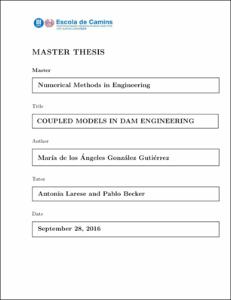Coupled models in dam engineering

Visualitza/Obre
Estadístiques de LA Referencia / Recolecta
Inclou dades d'ús des de 2022
Cita com:
hdl:2117/99980
Tipus de documentProjecte Final de Màster Oficial
Data2016-10-21
Condicions d'accésAccés obert
Llevat que s'hi indiqui el contrari, els
continguts d'aquesta obra estan subjectes a la llicència de Creative Commons
:
Reconeixement 3.0 Espanya
Abstract
Rock ll dams are certainly one of the most important engineering structures due to their
economic advantages and exible design. Unfortunately their vulnerability to overtopping
still remains their weakest point. For that reason, several research groups are interested in
both the numerical and experimental analysis of this phenomenon. In this work we focused
on the numerical analysis.
The previous work developed in CIMNE on a coupled PFEM-Eulerian free surface Compu-
tational Fluid Dynamic (CFD-PFEM) technique for the simulation of porous problems has
been studied and extended in the present work.
The Particle Finite Element second generation method (PFEM-2) has been used as an alter-
native to the Particle Finite Element Method (PFEM). Hence a new coupling strategy, called
CFD-PFEM-2, has been developed. On one hand, the uid free surface problem outside
and inside the rock ll slope is treated using a unique Eulerian xed mesh formulation. On
the other hand, the structural dam response is analyzed using a mixed Eulerian--Lagrangian
framework ( the PFEM-2 method).
A comparison between the coupled strategies CFD-PFEM, and CFD-PFEM-2 has been
performed. Additionally, all the numerical results are compared with experiments on
prototype rock ll dams.
The results obtained with the new strategy show a good agreement with both the experi-
mental results and the CFD-PFEM code. Furthermore, the computational efficiency between
the two numerical strategies was found to be almost identical. Given the similar accuracy
and required computational power, it is concluded that the CFD-PFEM-2 is a competitive
strategy to simulate the phenomenon.
TitulacióMÀSTER UNIVERSITARI EN MÈTODES NUMÈRICS EN ENGINYERIA (Pla 2012)
| Fitxers | Descripció | Mida | Format | Visualitza |
|---|---|---|---|---|
| TFM_María_González_Gutiérrez.pdf | 6,800Mb | Visualitza/Obre |


